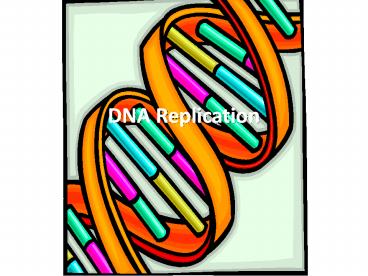DNA Replication - PowerPoint PPT Presentation
1 / 17
Title:
DNA Replication
Description:
DNA Replication Chromosome E. coli bacterium Bases on the chromosome DNA is very long!... but it is highly folded packed tightly to fit into the cell! – PowerPoint PPT presentation
Number of Views:209
Avg rating:3.0/5.0
Title: DNA Replication
1
DNA Replication
2
DNA is very long!... but it is highly folded
packed tightly to fit into the cell!For example,
a human cell contains more than 1 meter of DNA
made of more than 3 X 109 base pairs!
Chromosome
E. coli bacterium
Go to Section
Bases on the chromosome
3
DNA Structure
- Double helix made of nucleotides instructions
for life - Each nucleotide is made of three part
phosphate, a 5-carbon sugar and a nitrogen base
4
Nucleotide Base Pairing
- Four bases A (adenine), C (cytosine), G
(guanine), T (Thymine) - A will always bond with T
- C will always bond with G
5
Eukaryotic Chromosomes
- Contain DNA and proteins called histones
- Tightly packed DNA and proteins form chromatin
- During mitosis, the chromatin condenses to form
tightly packed chromosomes
6
(No Transcript)
7
Figure 12-10 Chromosome Structure of Eukaryotes
Section 12-2
Nucleosome
Chromosome
DNA double helix
Coils
Supercoils
Histones
Go to Section
8
Watson Crick again
- Earlier Discovered double helix of DNA
- Then DNA can be copied or replicated, because
each strand of the DNA double helix has all the
information needed to reconstruct the other half
by way of base pairing - The strands are complementary!
9
DNA Replication
- The process of making a copy of the DNA
- Occurs inside the nucleus of the cell
- Occurs when the cell is going to divide so each
resulting cell will have a complete set of DNA - During DNA replication, the DNA separates into
two strands, then produces two new complementary
strands following the rules of base pairing. - Each strand serves as a template, or model, for
the new strand. - Replication occurs in both directions
- The site where separation occurs is called the
replication fork
10
DNA Replication
- The two strands of DNA unwind or unzip breaking
the hydrogen bonds and separating. Then each
strand becomes the guide or template for the
making of a new strand. - A protein called an enzyme called DNA polymerase
breaks the nitrogen base bonds and the two
strands of DNA separate, polymerizes individual
nucleotides to produce DNA and proof reads the
new DNA. - The bases on each strand pair up with new bases
found in the cytoplasm - Then the sugar and phosphate groups form the
sides of each new DNA strand - Each new DNA molecule contains an original DNA
strand and a new DNA strand (semi conservative
model)
11
Figure 1211 DNA Replication
Section 12-2
Original strand
DNA polymerase
New strand
Growth
DNA polymerase
Growth
Replication fork
Replication fork
Nitrogenous bases
New strand
Original strand
Go to Section
12
STEP 1
- Two original strands of DNA separates by
unwinding - This occurs through the action of an enzyme that
breaks the hydrogen bonds between the strands - The two areas on either end where the DNA
separates is the REPLICATION FORK
13
STEP 2
- At the replication fork, DNA polymerase moves
along the DNA Strands adding nucleotides - As DNA polymerase moves along two strands of DNA
form
14
Step 3
- DNA Polymerase continues until all the
nucleotides have been added - Two new identical molecules of DNA are formed
- Another enzyme connects all the pieces of DNA
together
15
Proofreading
- At the end of Replication, DNA polymerase goes
through the DNA to make sure there are no errors - This prevents mistakes in the DNA sequences
- Mutations- Change in the sequence of the DNA
16
Like a Zipper.
17
Figure 1211 DNA Replication
Section 12-2
Original strand
DNA polymerase
New strand
Growth
DNA polymerase
Growth
Replication fork
Replication fork
Nitrogenous bases
New strand
Original strand
Go to Section































